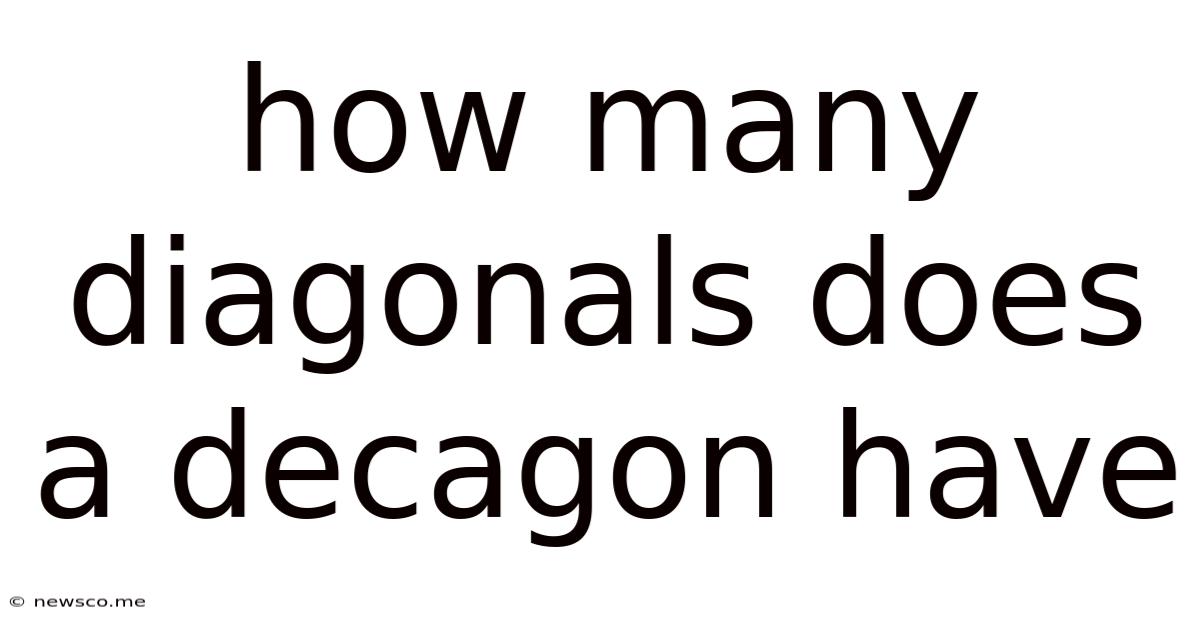How Many Diagonals Does A Decagon Have
News Co
Apr 12, 2025 · 4 min read

Table of Contents
How Many Diagonals Does a Decagon Have? A Comprehensive Guide
Understanding the number of diagonals in a polygon, such as a decagon, involves a fascinating blend of geometry and combinatorics. This comprehensive guide will not only reveal the answer to the question "How many diagonals does a decagon have?" but will also delve into the underlying principles, providing you with the tools to calculate the diagonals of any polygon. We'll explore various approaches, from basic counting to utilizing formulas, ensuring a clear and thorough understanding.
What is a Decagon?
Before we embark on calculating diagonals, let's establish a solid foundation. A decagon is a polygon with ten sides and ten angles. Polygons are closed, two-dimensional shapes formed by connecting straight line segments. Decagons can be regular, meaning all sides and angles are equal, or irregular, where sides and angles vary. However, the number of diagonals remains unaffected by the regularity of the shape.
Understanding Diagonals
A diagonal is a line segment connecting two non-adjacent vertices (corners) of a polygon. Crucially, it's not a side of the polygon. Imagine drawing lines within a decagon; those connecting adjacent vertices are sides, while those skipping over at least one vertex are diagonals.
Method 1: Visual Approach and Systematic Counting
The simplest, albeit most time-consuming approach, for a decagon is to visually count the diagonals. Let's try this:
- Choose a Vertex: Select any vertex on your decagon.
- Count Possible Diagonals from that Vertex: From this single vertex, you can draw diagonals to seven other vertices (excluding itself and its two adjacent vertices).
- Repeat for All Vertices: Since there are ten vertices, you might initially think there are 70 diagonals (10 vertices x 7 diagonals per vertex).
- Avoid Double Counting: The mistake lies in double-counting. Each diagonal is counted twice (once from each endpoint).
To correct the double-counting, we divide the initial result by 2. Thus: (10 vertices * 7 diagonals per vertex) / 2 = 35 diagonals.
Method 2: The Formula for Diagonals in a Polygon
A more efficient and general method involves using a formula to determine the number of diagonals in any polygon with n sides. The formula is derived from the combinatorial principle of selecting pairs of vertices:
n(n - 3) / 2
where n represents the number of sides (or vertices) of the polygon.
Let's apply this to the decagon:
n = 10 (since a decagon has 10 sides)
Substituting into the formula:
10(10 - 3) / 2 = 10(7) / 2 = 35
Therefore, a decagon has 35 diagonals.
Why Does the Formula Work?
The formula's elegance lies in its efficient handling of the double-counting issue. The term n represents the number of vertices to choose from as one endpoint of the diagonal. The term (n - 3) accounts for the fact that we cannot connect a vertex to itself or its two adjacent vertices. Dividing by 2 corrects for the double-counting of each diagonal.
Exploring Different Polygons
Let's apply the formula to other polygons to illustrate its versatility:
- Triangle (n=3): 3(3-3)/2 = 0 diagonals (triangles have no diagonals).
- Square (n=4): 4(4-3)/2 = 2 diagonals.
- Pentagon (n=5): 5(5-3)/2 = 5 diagonals.
- Hexagon (n=6): 6(6-3)/2 = 9 diagonals.
- Heptagon (n=7): 7(7-3)/2 = 14 diagonals.
- Octagon (n=8): 8(8-3)/2 = 20 diagonals.
- Nonagon (n=9): 9(9-3)/2 = 27 diagonals.
- Decagon (n=10): 10(10-3)/2 = 35 diagonals.
Practical Applications and Further Exploration
The ability to calculate the number of diagonals in a polygon isn't just an abstract mathematical exercise. It has practical applications in various fields, including:
- Computer Graphics: Algorithms for generating and manipulating polygons often rely on understanding their internal structures, including the number and properties of their diagonals.
- Engineering and Design: Analyzing the structural properties of frameworks and trusses often involves considering polygons and their diagonals.
- Combinatorics and Graph Theory: The problem of counting diagonals is closely related to more complex problems in these fields.
Advanced Concepts and Related Problems
This topic opens doors to more complex geometrical inquiries. For instance:
- Intersection of Diagonals: Investigating the number of intersections of diagonals within a polygon can lead to intricate patterns and relationships.
- Properties of Specific Diagonals: Exploring the lengths and angles of diagonals in regular polygons reveals interesting symmetries and geometrical properties.
- Generalizations to Higher Dimensions: The concept of diagonals can be extended to polyhedra (three-dimensional shapes) and higher-dimensional analogues.
Conclusion
Determining the number of diagonals in a decagon, or any polygon for that matter, involves a blend of geometrical intuition and combinatorial reasoning. We've explored two primary approaches: a visual, systematic counting method and a more efficient formula. The formula, n(n - 3) / 2, provides a powerful and generalizable tool for calculating the number of diagonals in any polygon. This understanding extends beyond a simple calculation, opening avenues for further exploration into the fascinating world of geometry and its applications. The 35 diagonals of a decagon represent just one piece of a larger, intricate geometrical puzzle.
Latest Posts
Related Post
Thank you for visiting our website which covers about How Many Diagonals Does A Decagon Have . We hope the information provided has been useful to you. Feel free to contact us if you have any questions or need further assistance. See you next time and don't miss to bookmark.